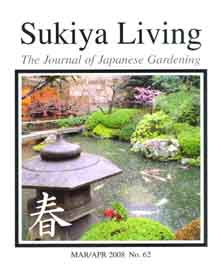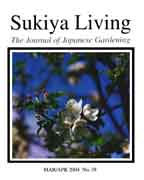|
Sukiya Living Magazine (JOJG)
Japanese Plants
 The
plant palette seen in Japanese gardens is typically very limited. It
is quite common for a garden to be composed of only a dozen or so different
plant types. Surprisingly, this limited palette does not seem to
curtail the beauty of a Japanese garden. To the contrary, the smaller
number of colors and textures enhances a feeling of unification and harmony.
The
plant palette seen in Japanese gardens is typically very limited. It
is quite common for a garden to be composed of only a dozen or so different
plant types. Surprisingly, this limited palette does not seem to
curtail the beauty of a Japanese garden. To the contrary, the smaller
number of colors and textures enhances a feeling of unification and harmony.
In nearly every case, the key to a successful Japanese garden lies, not in the plant itself, but in what the gardener does with the plant. With this in mind, pruning and garden layout are generally considered more important than plant selection.
The majority of plants used in Japanese gardens are evergreen trees and shrubs. This emphasis on evergreen material is related to the goal of creating four-season beauty. Deciduous plants such as Japanese maples are sometimes used as accents. Herbaceous annuals and perennials are rarely used except as minor grace notes.
While Japanese gardens are not known for their flowers, they do employ flowering trees and shrubs. Azaleas, in particular, are common and seen in nearly every garden in Japan.
Some, but not all, Japanese gardens display plants that may feel somewhat exotic to Westerners. These would include bamboo, moss, and carefully-pruned pine trees.
Sukiya Living Magazine (JOJG) runs regular "plant" articles about many different species including the plants mentioned above. Here are some of the general categories:
-----------------------------------------------------
AZALEAS Some experienced gardeners feel that azaleas, while often overlooked, are actually the single most important plant in Japanese gardens.
PINES There is no doubt that the 2-needled pine is the "king" of Japanese garden specimen trees.
BAMBOO Often used as an accent, bamboo is a fascinating element in many Japanese gardens.
JAPANESE MAPLES In Japan, the regular green species tree, Acer palmatum, is far more popular than colorful cultivars.
FLOWERING TREES & SHRUBS Contrary to Western belief, the Japanese people actually love flowers. Instead of planting herbaceous plants they tend to enjoy the seasonal bloom of woody trees and shrubs.
MOSS Moss grows abundantly in many parts of Japan. Known as koke in Japanese, it is a ground cover that is commonly seen in Japanese gardens. Some gardens in Japan have even been created around the moss theme and can be accurately described as "moss gardens." Read these articles to learn more.
------------------------------------------------------

